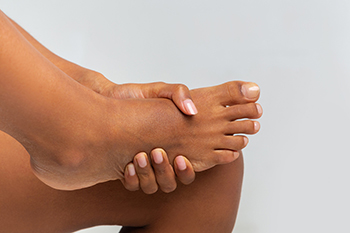Definition and Progression of a Plantar Fibroma
Tuesday, 28 November 2023 00:00
A plantar fibroma affects the foot's plantar fascia, resulting in the development of nodules or fibrous tissue. Characterized by a thickening of the ligament that supports the arch, this disorder commonly manifests on the bottom of the foot, near the heel. In its early stages, a plantar fibroma may present as a small, painless nodule. As the condition progresses, these nodules can enlarge and become tender, causing discomfort with weight-bearing activities like walking or standing. Over time, the fibrous tissue may intertwine with the plantar fascia, potentially leading to a reduction in foot flexibility. The stages of a plantar fibroma vary, with some cases remaining relatively stable, while others may experience increased symptoms. Understanding the definition and progression of a plantar fibroma is essential for early recognition and intervention, enabling individuals to explore appropriate management strategies and maintain optimal foot health. If you have discomfort on the bottom of your foot, it is suggested that you visit a podiatrist who can accurately diagnose and treat a plantar fibroma.
A plantar fibroma may disrupt your daily activities. If you have any concerns, contact Corinne R. Kauderer, DPM of Dyker Heights Foot & Ankle. Our doctor can provide the care you need to keep you pain-free and on your feet.
Plantar Fibroma
A plantar fibroma is a fibrous knot in the arch of the foot. It is embedded in the plantar fascia which is a band of tissue that extends from the heel to the toes along the bottom of the foot. There can be multiple plantar fibromas in the feet at the same time. There are no known causes for this condition. If you have a plantar fibroma, there will be a bump in the arch of your foot that cannot be missed. Any associated pain is most often due to a shoe rubbing against the nodule. Non-surgical options, such as steroid injections, physical therapy, and orthotics should be tried first. Surgery is a last resort and is the only thing that will remove a plantar fibroma entirely. Consult with a podiatrist for a proper diagnosis and to determine the treatment regimen that is right for you.
What Causes a Plantar Fibroma?
While there are no specific causes identified, a plantar fibroma can possibly come from genetic predisposition or the formation of scar tissue that forms from healing the tears in the plantar fascia.
What Are the Symptoms of a Plantar Fibroma?
There will be a noticeable lump in the arch of the foot that may or may not cause pain. If pain is felt, it is typically because a shoe is rubbing up against the lump or when walking or standing barefoot.
Treatment and Prevention
A plantar fibroma will not disappear without treatment, but it can get smaller and be a non-issue. If pain persists, a podiatrist examines the foot and when the arch of the foot is pressed, pain can be felt down to the toes. An MRI or biopsy might be performed to help diagnose or evaluate the plantar fibroma. The following non-surgical options are generally enough to reduce the size and pain of these nodules:
- Steroid injections
- Orthotics
- Physical therapy to help apply anti-inflammatory creams on the bump
Surgery is considered if the mass increases in size and the patient continues to feel pain after non-surgical methods are tried.
If you have any questions please feel free to contact one of our offices located in Brooklyn, NY and Old Bridge, NJ . We offer the newest diagnostic tools and technology to treat your foot and ankle needs.







